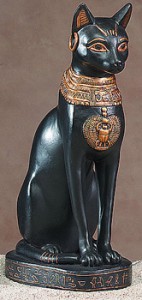God of the sun (originally), the moon (after the Greeks), cats, women, and secrets. Appearance of A desert cat, or a woman with the head of a cat (this form possibly dates after the domestication of the Egyptian wild cat). Probably the most famous Egyptian goddess after Isis, Bast was said to be the daughter of Ra, though long after he created the primal gods. She was originally a sun goddess, but after contact with the Greeks, she changed to a moon goddess, probably due to the Greeks associating her with Artemis.
 Like Artemis, Bast was a wild goddess. To those who were in her favor, she gave great blessings, but her wrath was legendary and she was sometimes listed as one of Ra’s avenging deities who punish the sinful and the enemies of Egypt. This is of course in keeping with her totem animal, the cat. Cats were sacred to Bast, and to harm one was deemed a great transgression. Bast’s importance in the Egyptian pantheon might be due to the great value placed on the domesticated cat by the Egyptians. Cats curtailed the spread of disease by killing vermin, and though the idea of microbes was unknown to the ancient Egyptians, they must have noticed the connection between rats and disease.
Like Artemis, Bast was a wild goddess. To those who were in her favor, she gave great blessings, but her wrath was legendary and she was sometimes listed as one of Ra’s avenging deities who punish the sinful and the enemies of Egypt. This is of course in keeping with her totem animal, the cat. Cats were sacred to Bast, and to harm one was deemed a great transgression. Bast’s importance in the Egyptian pantheon might be due to the great value placed on the domesticated cat by the Egyptians. Cats curtailed the spread of disease by killing vermin, and though the idea of microbes was unknown to the ancient Egyptians, they must have noticed the connection between rats and disease.
Her worship was widespread, and her cult apparently had a great deal of power. Bubastis was even the capital of Egypt for a time during the Late Period, and some pharaohs took her name in their king-names. Herodotus’ description of her temple at Bubastis is that of a place of great splendor and beauty, rivaled only by the temples to Ra and Horus. Worshipped widely throughout Egypt, her cult center was at Bubastis.